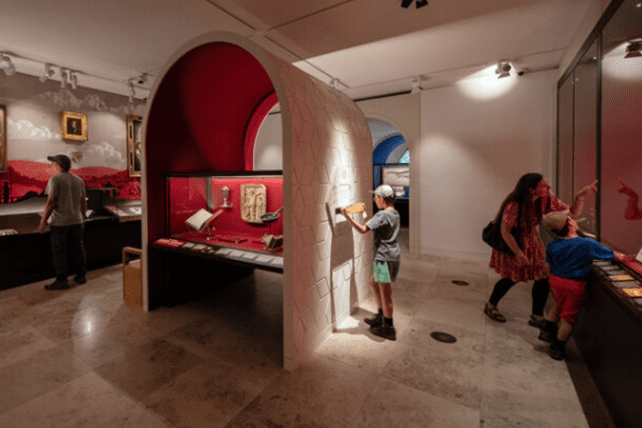At one point he walked away from the deal but was drawn back, he says, by the then-bishop of Durham’s efforts. Justin Welby, now archbishop of Canterbury, brought about reconciliation between him and the commissioners — a venture that partly involved meeting in a peace yurt at a church in the city of London. After first offering £15 million for the Zurbarán, he finally secured the castle and the pictures for £11 million.
The Zurbaráns remained in the castle dining room — where visitors can now see the biblical figures of Jacob and his sons, once purchased by Bishop Trevor to publicly show his support for Jewish naturalization rights at a time when the British Parliament was debating them. And the castle itself became the locus for the Faith Museum, which now occupies a separate old part of the castle, as well as a new extension built for the museum.
Ruffer says the Spanish Gallery reflects ideas of transience and eternity. While it also reflects his personal passion for the art of the Spanish Baroque, he says it is the newly opened Faith Museum that is closest to his heart. He describes it as his “comfort food for taking on the castle.”
“What I could see was that there is no faith museum anywhere, and the fact that it’s taken us 10 years to get to — it was the only specific, tangible thought I had, and it’s the last thing to fall into place.”
Ruffer — who claims that when he became a Christian, it was “not because I needed it but because it was true” — says he is not on a mission to proselytize with the Faith Museum, but rather to explain.
“I do think that what we are trying to do here hasn’t been done before. That doesn’t make us pioneers. It hasn’t been tried because it is impossible in an age like this when there is such an animus against people with faith, and those with faith are often vituperative toward others with faith.”
The Museum begins with a gallery tracing the origins of faith in Britain from 6,000 years ago and ends with contemporary artists and their personal responses to faith. In between are timelines and accounts of the dramatic twists and turns of faith in Britain and a collection of more than 250 objects from private and personal collections across Britain, many on loan as the Faith Museum works to build its own collection.
Among the highlights is a never-before-displayed object found less than a mile from the castle: the Binchester Ring. The silver ring was discovered during an excavation in 2014 at Binchester Roman Fort, and its carved carnelian stone inscribed with an anchor and fish is rare early evidence of Christianity in Britain.
A number of items on display highlight the various religious conflicts in Britain’s history, particularly the Reformation. An altar cover made from fragments of embroidered blue velvet, likely created after 1600 from vestments worn by pre-Reformation priests, symbolizes efforts to preserve the Catholic faith. There is also a 1535 document listing the annual incomes of 160 monasteries around Britain, after Henry VIII decided to tax them. Eventually he had them dissolved.
There is a rare example of William Tyndale’s English translation of the New Testament — a translation that led to his execution for heresy in 1536. Also on display is a wooden pulpit from 1760, from which the Methodist preacher John Wesley spoke when he visited the north of England.
A number of items in the museum point to the history of Christian charity in the country, including a set of brass musical instruments made at the Salvation Army’s own musical instrument factory.
The presence of other religions in Britain is also highlighted in the displays, including the 13th-century Bodleian Bowl, an early example of evidence of Jewish communities in Britain. This decorated bronze vessel is inscribed with the name of Joseph, son of Rabbi Yechiel, a famous Parisian Torah scholar. Joseph lived in Colchester and may have given this bowl to the Jewish congregation there before leaving for the Holy Land. There are also the prayer beads of Lord Headley, the first convert to Islam in Britain, who became a Muslim in 1913.

